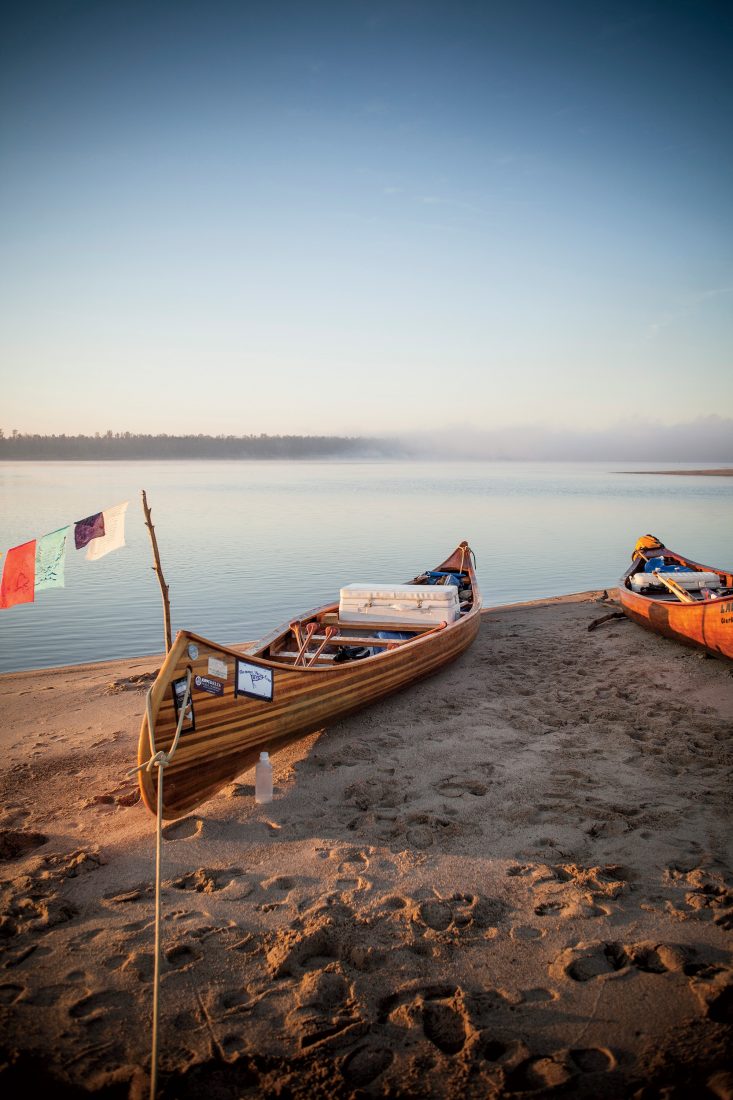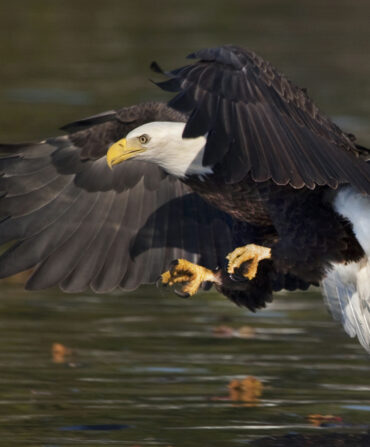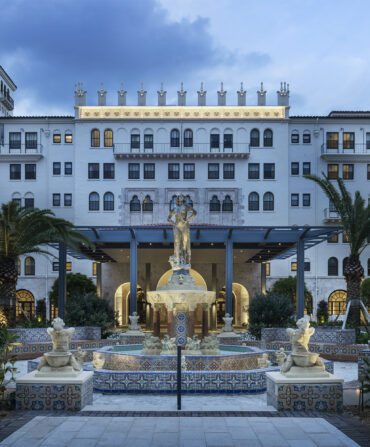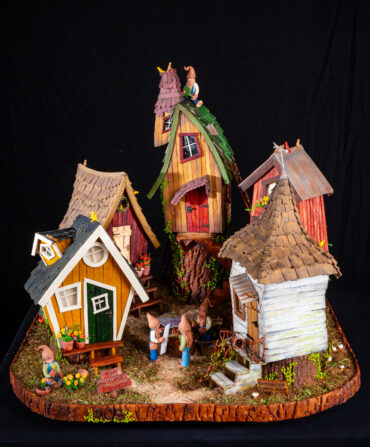Below me, the most storied river in North America swirls with silt so thick and dark it looks like some churning superhighway of mud. I’m standing on the bow of a wooden canoe looking down into it, and if you’d told me a few weeks ago I’d be here, getting ready to jump, I’d have told you you were crazy, because this is the middle of the Mississippi River and it is frigid. The water here is two-thirds of a mile wide and close to fifty feet deep. But at this point I’m on my second day of paddling through the Delta with the legendary river guide John Ruskey, and in that time, almost every preconception I’ve had about this river has changed. So I jump into the air and dive.
When I rise to the surface, gasping from the chill, someone says, “You’ve been baptized!” And even though there was nothing religious about my plunge, I think, Amen, yes indeed I have been.
This all started two days earlier in Clarksdale, Mississippi, the so-called Birthplace and World Capital of the Blues. Just a few blocks from the very crossroads where Robert Johnson is said to have sold his soul to the devil, I parked in front of the headquarters for Ruskey’s Quapaw Canoe Company. Established in 1998, Quapaw is the sole purveyor of year-round, custom-guided canoe excursions down the Lower Mississippi, and I’d come to its doors with the hope of experiencing the one thing even more central to the identity of the Mississippi Delta than blues music—the Mississippi River itself.
Pumping upwards of 3.3 million gallons into the Gulf of Mexico every second, the Mississippi is the world’s fourth largest river system. Yet in the South, there are precious few chances for anyone to actually see it. Memphis and New Orleans offer the greatest access, but they also do much to increase the impression that the Mississippi is nothing more than a fetid industrial canal. “It is stinky and it is polluted there,” Ruskey says of the river in those two major ports. “But what we’re showing is that there’s a whole other section of the river that you can’t see until you get out on it.”

Photo: Ben Gately Williams
River outfitter and expert paddler John Ruskey.
Ruskey, who is forty-nine, is a wizened river guru straight out of central casting. On the Mississippi one hundred to two hundred days a year, he has a face creased from sun and wind. He wears a dark beard and a salt-and-pepper mess of long tangled hair tied up into a ponytail and tucked under a worn felt hat. Curious, quiet, and thoughtful, he peppers his musical drawl with “right on” and, when he does open up, it’s usually to deliver mini-lectures on such topics as the invasive nature of the water hyacinth or the Latin etymology of the honey locust, knowledge he dispenses effortlessly.
Ruskey’s life on the Mississippi began in 1982, when, after reading Adventures of Huckleberry Finn in high school, he and a friend thought, “That’s a good idea.” It can be argued that just about anyone who reads Huck Finn thinks the same thing, but most of us stop right there. Not Ruskey and his friend. They made a raft out of oil drums and scrap lumber and put in one August day just above La Crosse, Wisconsin. Five months later they arrived in Mississippi and watched their raft break apart after a run-in with a pylon. “It looked like a potato chip that had been crushed,” Ruskey says of the raft’s rapid dissolution. “And so my first night in Mississippi was spent as a refugee on an island.”

Photo: Ben Gately Williams
A makeshift dryer for water boots.
These days Ruskey isn’t so green as to try floating around on a tangle of barrels and lumber, but he concedes that the Mississippi poses risks regardless of your craft. “It’s a rapscallion of a river,” he says. “Just when you think you know everything about it, it does something different.”
With a foundation of experience and the right equipment, Ruskey and his mighty Quapaws plan their wilderness excursions as if they’re mountaineers setting out for an Alpine crossing. My baptismal dive, for example, was no carefree plunge. Quapaw requires passengers to wear wet suits when the water is 60 degrees or cooler and only recommends diving where the channel is free and deep. Ruskey says that most problems on the Mississippi stem from inexperience and lack of proper preparation, risks that don’t stand a chance out there with him and his Quapaws.
After my swim, we paddle out of the channel and move closer to the bank. We travel in two voyageur-style canoes based on those used by French-Canadian fur traders, each of them close to thirty feet long and handmade by Ruskey. The paddling is low impact but steady, and I compensate for my lack of experience by adopting a general willingness to just join in and go for it.

Photo: Ben Gately Williams
One of Ruskey’s handmade canoes.
A hunter on a bluff catches sight of us as we pass and calls out, “Where you going?” Ruskey’s right-hand man, Quapaw guide Mark “River” Peoples, says, “Vicksburg!” naming our final destination, which lies more than a hundred miles south. The hunter remains silent for a moment, then, with the voice of one who simply cannot believe what he has just heard, says, “Vicksburg?!”
We all burst into laughter. Out here on top of it, so close to it, dripping with it, the river feels like our own special secret. But this is a secret Ruskey is intent on not keeping. “The people here, they just don’t think about the river,” he says, summing up just about everything he’s working to change. “Sharing the beauty of it is our mission. Sixty-five percent of my time is spent talking to people and illuminating exactly what the experience of being on the river is.”
After having paddled more than twenty miles, we call it a day on the banks of a secluded Arkansas landmass named Island 78, as remote a piece of earth as I’ve ever set foot on in my life. Its sandbar extends for close to a mile before reaching a line of distant willows and stretches so wide that it looks like some odd combination of the Caribbean and the moon. I ask whose land this is and Ruskey says, “This is no-man’s-land, really. The wildlife preserve starts there.” He points at the distant trees. “But this is usually underwater.” I realize what he means: Most of the time, when the Mississippi is at its normal height—twenty-five feet higher than it is now, which is a historic low caused by drought—the water would reach all the way up to those trees, and the sandbar we are standing on wouldn’t even exist.
“People think the Mississippi is filled with monsters and boat wrecks,” Peoples says, “but this, this is actually what’s under the Mississippi.”
And so, it occurs to me, we are essentially standing on the bottom of the Mississippi River. And it’s beautiful.

Photo: Ben Gately Williams
Explorers' Club
Fellow canoeists on break.
The group of us—more than a dozen passengers total, including adventurers, writers, photographers, conservationists, guides, and even Ruskey’s five-year-old daughter—spread out across the sand and begin to set up camp. The Quapaws light a driftwood fire and start a pork chop stew that smells so good I immediately want to eat ten bowls of it. The campsite, spotted with the pristine tracks of herons, coyote, deer, raccoon, and beaver, is soon also dotted with bright little tents. One passenger, a celebrated Chinese poet, plants a few paddles in the sand and hangs from them a line of colorful prayer flags. As stew is served and seats are taken around the fire, whiskey is poured and the stars begin to appear.
Keith Kirkland, an experienced river conservationist from the Wolf River Conservancy, in Memphis,Tennessee, looks around in the fading light and, in a drawl filled with disbelief, says, “Well, this is the best camp …ever.”
We experience no shortage of remote and wild beauty on these secluded islands, but very little of our time on the Mississippi is actually filled with silence. Everywhere on the river one hears the roar of towboats. A 1.5-trillion-dollar national industry, towboats have become almost the sole traffic on this stretch of water. Some push fleets of barges six across and seven deep—a conglomeration of vessels so large it covers six acres of water. As they pass, many of these ships whip their massive floodlights through the dark and train them directly onto our campfire. It’s as if they can’t believe that they’re actually seeing humans here.
“They aren’t as surprised as they used to be,” says Peoples, squinting into a floodlight. “We’re changing the perception of the river just by being out here.”
In the morning, before we leave camp, Ruskey draws long looping lines in the sand with a beaver-stripped branch. I think this is some sort of shamanistic snake art until he tells everyone to gather around. Then I realize what he has actually drawn: a map of the river itself. It’s just another example of the constant effort Ruskey makes to emphasize the interconnectedness of all the waterway’s disparate parts.
“When Old Faithful blows its top,” Ruskey says later, drawing out the point, “that water goes down the Mississippi.”
“If you look at it,” adds Peoples, “the drainage system of the river looks just like the circulatory system of the human body. And if this river isn’t healthy, the country isn’t healthy.” This is another point the Quapaws all seem bent on making clear: that man’s effect on the river is profound.
That afternoon, as we pass the banks that brought the world the likes of B. B. King, Robert Johnson, Muddy Waters, and Howlin’ Wolf, Ruskey takes his own guitar out of a dry bag and begins to play the blues.
“Going down the Mississippi in my big canoe,” he sings while his daughter, who has just awoken from a nap atop the cargo pile, drums along in joy.
Later Ruskey brings the canoes together and we all fall silent. He offers a quiet meditation about the river and then playfully rises into a headstand on the stern of his boat. He quivers there for an instant, like some bearded reed grown straight off the redwood craft, before pushing himself off and into the water. The distinctions between boat, man, and river all seem to have become ambiguous here, and the joke about my so-called baptism earlier suddenly seems a lot less silly. Touched by these muddy waters, I’m not the only one who’s been transformed by the Mississippi River. In it, on it, or near it, the South is thus consecrated each and every day. Ruskey and the Quapaws are just doing their best to not let us forget it.









